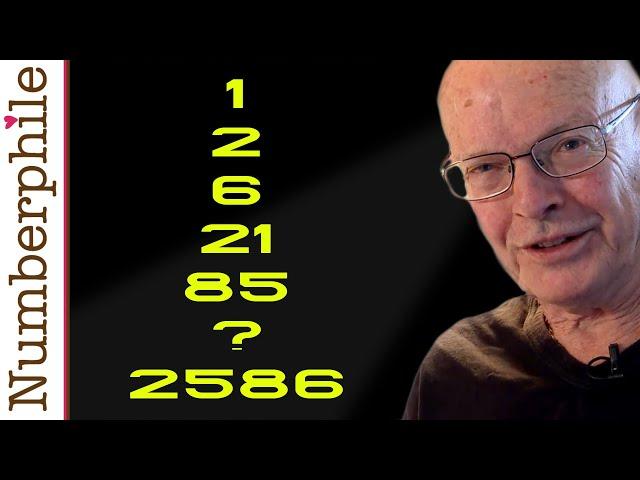Комментарии:

Yo maybe the sequence was inverse normal normal inverse normal normal inverse!
Ответить
After x2 (to get 6) and x3 (to get 21), I was expecting the next one to be x5...
Apparently not everything sequence is based on prime numbers or some kind of Fibonacci pattern? \o/

😍😍😍
Ответить
I can prove that sequence is correct
Sequence:1 , 2 , 6 , 21 , 85 , 430 , 2586
Now from 1to 2:it is +1*1
From 2 to 6: it is +1*2
From 6 to 21 :it is +1*3
From 21 to 85:it is *4+1
From 85 to 430:it is +1*5
From 430 to 2586:it is +1*6
Kk now see first three alternate algorithm
That is +1*1 , +1*3 , +1*5
Here algorithm pattern is +1*(odd)
Here we get +1*7 as next pattern.
Next three alternate algorithms that is
+1*2 , *4+1 , +1*6
Here this algorithm pattern is first +1first and then last and again up similarly
*2 last *4 first *6 last so then *8 first
So here we get *8+1 as next pattern .
Next number after 2586 is
2586*1+5 means 2591
And next number is
2591*8+1 means 20729

More videos of him pls
Ответить
How can I contact you please
Ответить
It might have been a typo. Number 5 is next to 8 in the numpad.
Ответить
Ha! I figured it out without having seen the video or the answer first. I saw the pattern from 1 to 2 to 6 to 21 and realised the mistake you’d have to make to get to 85, but of course I wasn’t sure of the pattern I’d found. But then I used the pattern backwards from 2586 and got 430 and 85. It’s always fun when once in a while you manage to be smarter than the teacher, but of course I was helped a little by Brady’s spoiler headline “a sequence with a mistake”.
Ответить
dude am i a genius or wot?
i just want to test my self just after i have seen the sequence and i literally find the pattern in less than 2 minutes without seeing the answer.
what i have done is 1*1+1, 2*2+2=6, 6*3+3 .....
which i also same like this guy told.
😁

Why does it look like this guy lives in a circus tent?
Ответить
This is also known as the Parker sequence.
Ответить
paused it. got 430.
Ответить
I recognized 21 to 85 instantly because of the Collatz Conjecture
Ответить
Haha, I figured it out on my own by inadvertently making the same mistake 🙈
Ответить
Kinda thing puts you off puzzles
Ответить
'Voorwerp' = Object
'Bedriegers gedijen nooit' = Frauds/cheaters never do well

Now I want to know the correct sequence.... Or I have to calculate it by myself.
Ответить
Neil: Thank you for your beautiful OEIS.
Ответить
You probably know this "joke". Einstein was asked by a teacher what number comes next in this sequence:
0, 0, 0, 0, ?, . . . The teacher of course expected the answer to be "zero." But Einstein answered, "24". (If you don't know what pattern would make that answer correct, think about it.) You can use the pattern (assuming you find the one I am thinking of) as the basis for a proof that for any finite string of numbers a1, . . ., an, and any number b whatsoever, there is a simply defined algebraic function f with f(1) = a1, . . . , f(n) = an, and f(n+1) = b. (This bothered me when I took the Postal Exam back in my 20s, as they had such what's-the-next-number questions on it.)

Butchering the pronunciation of Voorwerp 😂
Ответить
I love this channel is very beautiful
Ответить
I don’t think there’s an error. Just a equation that wasn’t found. I believe every sequence or pattern has a equation—most more complicated than others.
Ответить
I have exactly description for π by real equation and I am provide that ; this the description is the first time in the world discovered by me & in the soon l will declare theory called π theory to engineer m.
Ответить
or... pattern is every 4th step you X4 & +1
Ответить
In general, let s(x) = ((-3*a + 1757)*x^6)/360 + ((66*a - 37680)*x^5)/360 + ((-570*a + 319610)*x^4)/360 + ((2460*a - 1361190)*x^3)/360 + ((-5547*a + 3039413)*x^2)/360 + ((6114*a - 3325950)*x)/360 - 7*a + 3790,
then your answer is a.

The puzzle is right, it could be any number. For example, it could be 0.
Let s(x) = 1757/360*x^6 - 314/3*x^5 + 31961/36*x^4 - 45373/12*x^3 + 3039413/360*x^2 - 36955/4*x + 3790, then
s(1) = 1,
s(2) = 3,
s(3) = 6,
s(4) = 21,
s(5) = 85,
s(6) = 0,
s(7) = 2586.
DONE.

Interesting - being told in the thumbnail that one of the numbers is wrong makes it trivial - even without watching the video - I figured out the algorithm in a few seconds and it took another 20 to verify. Hmmm. You are told there is a mistake, not that ONE of the numbers is wrong, and that actually leads to THREE of the numbers being wrong; the last three. It's a nice twist that the answer to the puzzle is a number that is wrong.
Ответить
There's no mistake; it's just part of the rule that you switch the order of operations for every fifth term ;)
Ответить
we should send this sequence to exoplanets with potential to host intelligent life and see if they figure out if this was a puzzle with a mistake ... i wonder how they will reply
Ответить
whenever i see questions like these it’s never mathematical. more like, say the word for this number in french, and use the first syllable to build a new number in english, and so forth.
Ответить
Sir, I am afraid I disagree. It was done by hand, and the handwriting was so bad, they read an 88 to be an 85. I think that is a lot more probable than the explanation you found.
Ответить
I solved this a bit differently (sorry my bad english)..
If we assume that this is a steadily increasing sequence (that is, there are no regressive steps in between), x can be equal to 267 and 586, or anything in between.
If we assume that the missing number is 430, then we have the following sequence:
1, 2, 6, 21, 85, 430, 2586
If we look at the difference of each of the following members with the previous member, we get a new sequence:
1, 4, 15, 64, 345, 2156
If we do the same now with this sequence and also with the new sequences obtained, we get 5 more sequences with the same methodology:
3, 11, 49, 281, 1811
8, 38, 232, 1530
30, 194, 1298
164, 1104
940
This 940 is, so to speak, a support-difference that is going to remain constant all the time - it allows us to derive backwards the following member of a given base sequence, which should come after 2586:
1, 2, 6, 21, 85, 430, 2586, 11425
1, 4, 15, 64, 345, 2156, 8839
3, 11, 49, 281, 1811, 6683
8, 38, 232, 1530, 4872
30, 194, 1298, 3342
164, 1104, 2044
940, 940
So, next member should be 11425..

"I cheated to look up the answer." What did you cheat at to look up the answer?
Looking up the answer in this particular case is not cheating.

I think this sequence goes like x*n+n where x is the number and n=1,2,3......
And i think this video is a trap. 👍👍

Like enigma coding
Ответить
He sounds like Professor Hubert J. Farnsworth (the old guy in Futurama) and it's awesome!
Ответить
Any sequence is technically possible
Ответить
Obviously there is no mistake. The pattern is just AAABAAABAAAB.... where A is "+1*n" and B is "*n+1" :)
Ответить
These many wrong questions is a standard in exams that include MAT in IN
Ответить
Thank you for a clear demo; solving a ‘number sequencing’ problem’ w/a large paper sheet, colored markers (wide-tip), and a large font. Following along & being ability to apply the method was delightful!
Ответить
Also thought I would add a hint if anyone wants to try and work out the sequence 1, 2, 6, 21, 85, 516, 2586, 11470, 47883.... Often for challenging sequences I like to think of how that sequence maps/relates to base 2, ie binary representation. The simplest "landmarks" are with one bit in various positions, ie 2^n. The numbers in this sequence will be between incremental ranges of this. The method I then used was to see how far away this was from a previous landmark and how much to get to the next one. Then mapped a pattern to these differences involving a repeating pattern of a remainder left over after a division. It was this remainder that repeated itself and thus was a "key" to one way of producing this pattern. This is also an interesting technique that I have applied to the collatz sequence and gilbreath conjecture. Life gets in the way of pondering maths for me but if either of these areas are of interest to you I would encourage you to think of number theory problems/puzzles in terms of the structure of the underlying information. Various measures of info complexity ("entropy") can be created and in the case of the collatz sequence can be seen to "drive it". Bit like 2nd law of thermo in physics. Just like modelling nature the math process is just doing what it is doing but in defining an algorithm/equation for info complexity we can see how a process is evolving by how the measure of complexity is changing. Oh well, I am off on tangents again!
Ответить
I paused the video and thought about it for longer than probably should have. I did come up with a way to generate a pattern with the 85 in place. The missing number, 6th term, I got was 516. Shocked when I played video and saw 430. Anyhow, for those that want to really challenge themselves. The sequence I came up with goes 1, 2, 6, 21, 85, 516, 2586, 11470, 47883 .....It's definately a pattern to the sequence but not easy to discover!
Ответить
😃😃
Ответить
So then the actual answer should be 445 followed by 2676.
UNLESS, perhaps the pattern is actually a fractal that's way too complex (say x raised to some arbitrary irrational and rounded to the nearest whole integer) to be solved by us pea-brained humans.

He would be the perfect reader for Spike Milligan's poems for children. "There are holes in the sky where the rain gets in, but the holes are quite small; that's why rain is thin."
Ответить
And so the author of the sequence quiz spent the rest of his life in destitute, shamed and forgotten.
Ответить
12/2=6 126/6=21
thought I was on to something there



























